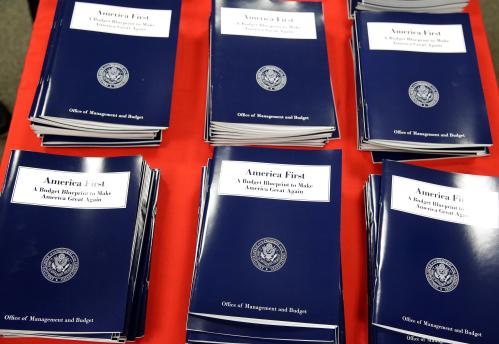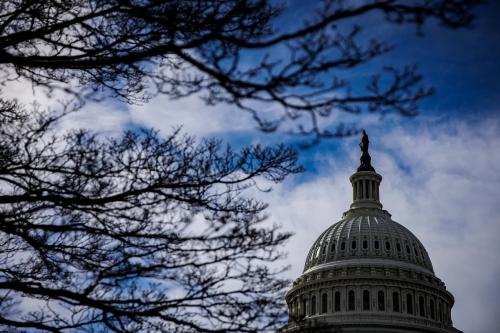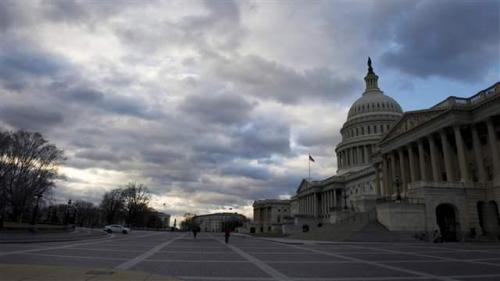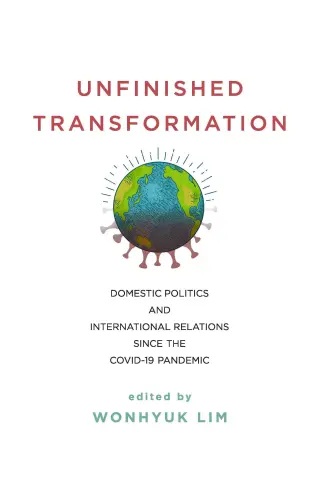Every year, Congress is tasked with creating and passing a federal budget for the upcoming fiscal year. This process is often fraught with tense debate and, in the recent past, disagreements over funding have led to federal government shutdowns.
The budget process begins on the first Monday in February following the President’s budget proposal submission, and can last as long as fall or winter of that year. As this year’s budget process reaches its climax, here is what you should know about the budget process, and what Brookings experts believe should be included in the budget this year.
The president’s budget proposal is like a wish list
Federal budget legislation originates in the House of Representatives, not in the White House. Thus, the president’s budget proposal is more akin to a suggestion than a serious framework for legislation. The White House’s budget proposal is a place where the president outlines his wish list for the upcoming fiscal year and, while Congress can consider the recommendations, it is merely a starting point in the longer budget process and debate.
A budget resolution is like a New Year’s resolution
After the president submits a budget proposal, the House and Senate work to adopt a congressional budget resolution. Both the House and Senate passed their congressional budget resolutions for fiscal year 2018 last week. Brookings Senior Fellow Sarah Binder compares budget resolutions to New Year’s resolutions, arguing that they tend to be more aspirational than enforceable—not least because they are not sent to the president to be signed into law. She explains that the House budget adopted at the beginning of October—and now subsequently compromised with the Senate’s version—amounts to a Republican wish list on spending and taxing priorities.
Brookings Fellow Molly Reynolds notes that many Senate rules, procedures, and evolving norms have had the unintended consequences of slowing down and delaying the Senate as it tries to complete a budget resolution. Specifically, she points to the various ways in which senators’ freedom to introduce amendments or otherwise generate “credit-claiming” opportunities in other parts the legislative process has declined in recent years, leading senators to pursue those goals as part of the budget process. She recommends reforms to the procedures for considering the Senate budget resolution that could make the process run more smoothly, but cautions that any changes have to accommodate senators’ underlying political motives.
Partisan arguments are only part of the problem
While partisan arguments over the composition of the budget are prevalent, Casey Burgat and Joshua Hudar argue that partisanship is not the cause of Congress’ recent failures to produce a budget. Instead, they say that the source of congressional dysfunction is the tendency of members of Congress to use budget propositions to communicate with their constituents, instead of creating feasible plans that focus on governing. Burgat and Hudar explain, “Budgets offered by both parties have morphed from honest funding proposals to party position papers.” This, they say, leads to a budget process that is highly publicized, filled with tension, and can cause debt crises and government shutdowns.
Why do we have a debt ceiling?
The subject of the debt ceiling often comes up when Congress is attempting to pass a budget. The debt ceiling is a limit imposed by Congress that dictates how much borrowing the Department of the Treasury can do to pay existing obligations of the government; the limit can be increased or decreased by Congress.
Brookings Senior Fellow Phil Wallach takes issue with the debt ceiling, explaining that it attempts to stop the debt without directly addressing the processes that generated the debt. He elaborates: “We have an appropriations process where we decide what to spend on discretionary spending, we have entitlement statutes that obligate our spending, and we have tax laws that determine how much revenue comes in—those are the laws that actually determine how indebted this country will become, and the debt ceiling is an afterthought.”
Five major issues that will shape this year’s budget process
As we near the end of the budget process, Brookings experts predict that five issues will shape what could be a down-to-the-wire funding debate.
- Tax reform.
Bill Gale, senior fellow in Economic Studies and co-director of the Tax Policy Center, discusses the Republican effort to cut taxes. He says the effects of the planned cuts will be felt by Americans at all income levels, and could influence upcoming congressional races, as the GOP has made tax policy a priority for their budget agenda. However, Gale argues that tax reform will be difficult for President Trump. As he put it, “tax reform is difficult politically because it creates a set of winners and a set of losers, and those losing out tend to be more vocal in their opposition to the reforms than the winners are in their support.”
- The border wall.
The politically divisive wall that President Trump has vowed to build to build along the United States’ southern border with Mexico is also likely to be a salient issue of debate throughout the budget process. Brookings Senior Fellow Vanda Felbab-Brown observed that, though Trump has said the wall will cost $12 billion dollars; other estimates have put it closer to $300 billion dollars.
- Foreign assistance.
President Trump has pushed for a 30 percent budget cut to U.S. foreign assistance programs. Brookings Senior Fellow George Ingram explains how foreign assistance keeps us safe, meets a moral imperative, and builds economic prosperity. While most Americans believe that foreign aid makes up about 25 percent of the federal budget, it really accounts for as little as 1 percent. Ingram explains that the money we provide foreign nations in assistance “can be viewed as an insurance policy against more expensive and more dangerous conflicts that would require the use of American troops in the future.”
- Infrastructure.
Improving U.S. infrastructure was a high-priority issue during the 2016 election. Then-candidate Trump notably announced that he would invest $1 trillion in an infrastructure bill to tackle the United States’ infrastructure crisis. Brookings Fellow Adie Tomer explained that U.S. infrastructure is under more strain than ever due to more Americans driving, increasing investments in public transportation, and an increase in goods transported across the nation. In fact, 80 percent of freight goods move along just 10 percent of trade corridors in the United States.
The need for investment in infrastructure will only become a more and more critical issue with time. Tomer and Associate Fellow Joseph Kane discusses the need for higher investment in infrastructure in the United States as the population grows, climate pressures intensify, concerns rise over health and safety, and pipes, sea walls and treatment facilities begin to buckle under pressure.
Tomer also highlight the pressure our water infrastructure is facing. Municipal water agencies need about 600 billion dollars in investment, but only 17 percent of these agencies think that they have the capacity to make these investments. These overwhelming and crucial infrastructure issues have led many to believe that infrastructure investment must be a priority in this fiscal year’s budget, and will remain a focus throughout the budget process.
- Entitlements.
Entitlement programs in America have a long-term effect on the country’s fiscal and economic condition, and are therefore at the forefront of every budget debate. Brookings Senior Fellow Stuart Butler and Maya MacGuineas of the Committee for a Responsible Federal Budget argue that today’s budget-making procedures fail to provide an orderly pathway for helping to resolve disputes about long-term fiscal goals and commitments to Americans. Butler and MacGuineas explain that Congress should enact a long-term plan that lays out the next 25 years of spending on major entitlements, along with a clear funding plan to cover their costs.
For more, see Brookings research on federal fiscal policy.
The Brookings Institution is committed to quality, independence, and impact.
We are supported by a diverse array of funders. In line with our values and policies, each Brookings publication represents the sole views of its author(s).







Commentary
What to expect from the budget process and debate
October 31, 2017